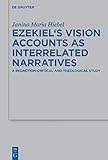Ezekiel’s Vision Accounts as Interrelated Narratives : A Redaction-Critical and Theological Study / Janina Maria Hiebel.
Material type: TextSeries: Beihefte zur Zeitschrift für die alttestamentliche Wissenschaft ; 475Publisher: Berlin ; Boston : De Gruyter, [2015]Copyright date: ©2015Description: 1 online resource (393 p.)Content type:
TextSeries: Beihefte zur Zeitschrift für die alttestamentliche Wissenschaft ; 475Publisher: Berlin ; Boston : De Gruyter, [2015]Copyright date: ©2015Description: 1 online resource (393 p.)Content type: - 9783110403640
- 9783110406825
- 9783110406658
- 224/.4066
- online - DeGruyter
- Issued also in print.
| Item type | Current library | Call number | URL | Status | Notes | Barcode | |
|---|---|---|---|---|---|---|---|
 eBook
eBook
|
Biblioteca "Angelicum" Pont. Univ. S.Tommaso d'Aquino Nuvola online | online - DeGruyter (Browse shelf(Opens below)) | Online access | Not for loan (Accesso limitato) | Accesso per gli utenti autorizzati / Access for authorized users | (dgr)9783110406658 |
Browsing Biblioteca "Angelicum" Pont. Univ. S.Tommaso d'Aquino shelves, Shelving location: Nuvola online Close shelf browser (Hides shelf browser)

|

|

|

|

|

|

|
||
| online - DeGruyter I «Diarii» di Marin Sanudo (1496–1533) : Sondaggi filologici e linguistici / | online - DeGruyter Hazardous Future : Disaster, Representation and the Assessment of Risk / | online - DeGruyter Die Hieroglyphe im 18. Jahrhundert : Theorien zwischen Aufklärung und Esoterik / | online - DeGruyter Ezekiel’s Vision Accounts as Interrelated Narratives : A Redaction-Critical and Theological Study / | online - DeGruyter Kritische Gesamtausgabe. Band 19, Briefe II (1894-1904) / | online - DeGruyter Binominal Quantifiers in Spanish : Conceptually-driven Analogy in Diachrony and Synchrony / | online - DeGruyter Satiren : Lateinisch - deutsch / |
Frontmatter -- Table of Contents -- List of Tables and Charts -- Acknowledgments -- Abbreviations -- 1. Introduction -- Part I: The Interconnected Redaction History of Ezekiel’s Vision Accounts -- 2. Ezekiel 1:1–3:15 -- 3. Ezekiel 8–11 -- 4. Ezekiel 37:1–14 -- 5. Ezekie l 40–48 -- 6. Relations among the Vision Accounts in Ezekiel -- Part II: Theology in a Diachronic Perspective -- 7. Discourse and Rhetoric: How the Vision Accounts “Function” -- 8. YHWH and Israel: The Death and Re-Creation of a Relationship -- 9. Of Monsters and Men: Intermediate Agents in the Vision Accounts -- 10. Conclusion -- Appendix A: The Text of Ezekiel 1:1–3:15 and 3:22–27 -- Appendix B: The Text of Ezekiel 8–11 -- Appendix C: The Text of Ezekiel 37:1–14 -- Appendix D: The Text of Ezek 40:1–41:4*; 42:15–43:12; 44:1–6; 47:1–12 -- Bibliography -- Index of Scripture References
restricted access online access with authorization star
http://purl.org/coar/access_right/c_16ec
Ezekiel is one of the best-structured books in the Old Testament. It is commonly recognized that the strongly interrelated vision accounts (Ez 1:1–3:15; 8–11; 37:1–14; 40–48) contribute greatly to this impression of unity. However, there is a marked lacuna in publications focusing on the vision accounts in Ezekiel as an interconnected text corpus. The present study combines redaction-critical analysis with literary methods that are typically used in a synchronic approach. Drawing on the paradigm of Fortschreibung, it is the first to present a united redaction history that takes into account the growing interconnections and dependencies between the vision accounts. Building on these results, the second part follows the development of selected themes, such as the relationships between characters, the roles of intermediate figures and anthropological and theological implications, throughout the stages of redaction.The study thus represents an important step towards an understanding of the complex redaction history of the book of Ezekiel, and indeed of its theology. The combination of diachronic and synchronic methods makes it relevant for scholars of both directions and is itself a methodological statement.
Issued also in print.
Mode of access: Internet via World Wide Web.
In English.
Description based on online resource; title from PDF title page (publisher's Web site, viewed 28. Feb 2023)


